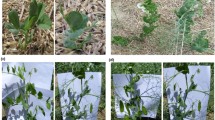Abstract
Pea seeds were irradiated with neutrons. At least 9 mutations have been found. Probably all are recessive. Some are undesirable, some have practical value. At least one mutant represents a completely new characteristic. One mutation occurred more than once. Three times two mutations occurred in one seed.
Irradiation with neutrons is considered to present a valuable means in plant breeding.
Samenvatting
Teneinde ervaring op te doen over de waarde van neutronen voor het verkrijgen van mutanten, werden droge zaden van erwten bestraald met een intensiteit van 5.1×108 n/cm2/sec; een bestralingsduur van slechts 1/2 uur bleek toelaatbaar. In X2 werden de navolgende mutanten gevonden, waarschijnlijk alle recessief:
-
1.
“Bossig”, zeer sterk vertakkende planten.
-
2.
Wasloos, zonder een wasovertrek op stengel en blad.
-
3.
Chlorina, gele kiemplanten, die spoedig afsterven.
-
4.
Dwergen, uiterst kleine planten, die zonder speciale behandeling geen zaad zetten; na toediening van gibberellazuur strekte de stengel en had zaadzetting plaats.
-
5.
“Lepelblad”, steunbladen die smal elliptisch en gesteeld zijn, gelijkend op een lepel; steeds gepaard met “open bloemen”, waarin stamper en meeldraden vrij liggen van de kiel.
-
6.
Ongekleurde bladoksel.
-
7.
Vroege bloei, 12 dagen eerder dan het uitgangsras, uit de 10e stengelknoop in plaats van uit de 16e.
Twee mutanten, chlorina (in ander materiaal dan sub 3) en acaciablad, werden pas in de X3 voor het eerst gevonden. Verondersteld is, dat zij ontstaan zijn na mutatie van “mutagene genen”.
Sommige der mutanten zijn zeker waardevol vanuit een veredelingsstandpunt en als eerste oriëntatie zijn de resultaten hoopvol. Eén mutatie is vaker dan eens opgetreden. Driemaal hebben 2 mutaties in 1 zaad plaats gehad.
Similar content being viewed by others
References
Gelin, O., Ehrenberg, L. and Blixt, S., Genetically conditioned influences on radiation sensitivity in peas. Agr. Hort. Gen. 16 (1958): 78–102.
Lamprecht, H., Rontgen-Empfindlichkeit und genotypische Konstitution bei Pisum. Agr. Hort. Gen. 14 (1956): 161–176.
Lamprecht, H., Durch Röntgenbestrahlung von Pisum-Samen erhaltene neue und bekannte Genmutationen. Agr. Hort. Gen. 15 (1957): 142–154.
Lamprecht, H., Eine fruticosa-Röntgenmutante von Pisum. Agr. Hort. Gen. 16 (1958): 130–144.
Verkerk, K., Neutronic mutations in tomatoes. Euphytica 8 (1959): 216–222.
Wellensiek, S. J., Mutagenic genes. Proc. Kon. Ned. Akad. Wetensch. C62, 1959: in the press.
Additional information
(Publication 199, Laboratorium voor Tuinbouwplantenteelt Landbouwhogeschool, Wageningen)
Rights and permissions
About this article
Cite this article
Wellensiek, S.J. Neutronic mutations in peas. Euphytica 8, 209–215 (1959). https://doi.org/10.1007/BF00039361
Received:
Issue Date:
DOI: https://doi.org/10.1007/BF00039361




